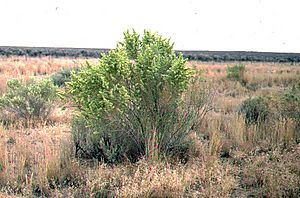Atriplex canescens facts for kids
Quick facts for kids Atriplex canescens |
|
|---|---|
 |
|
| Scientific classification | |
| Genus: |
Atriplex
|
| Species: |
canescens
|
Atriplex canescens is a cool plant often called chamiso, chamiza, or four-wing saltbush. It's an evergreen shrub, meaning it stays green all year round. You can find it growing naturally in the western and midwestern United States. It belongs to the plant family Chenopodiaceae.
Contents
What Does Four-Wing Saltbush Look Like?
This plant can look quite different from one place to another. It can even mix its genes with other plants in the Atriplex family. This means you might see it in many shapes and sizes!
Most four-wing saltbush plants are usually 2 to 4 feet tall. But some can be as short as 1 foot or as tall as 10 feet. Its leaves are thin and measure about 0.5 to 2 inches long.
The easiest way to spot this plant is by its special fruits. These fruits have four "wings" that stick out at right angles, like a cross. They grow very close together on long stems.
This plant blooms, or flowers, from April all the way through October.
Where Does Four-Wing Saltbush Grow?
Four-wing saltbush often grows in new or changing areas. You might see it in places where the ground has been disturbed, like after a fire or construction. It also loves to grow in active sand dunes, where the sand is always shifting.
You can also find it in older, more settled areas. Here, it often grows alongside plants like sagebrush and shadscale.
How Have People Used Four-Wing Saltbush?
Native American groups have used four-wing saltbush for a long time.
- The Zuni people used it for medicine. They would make a special tea from its dried roots and flowers to help with ant bites. They also used a paste made from the flowers for the same purpose.
- The Zuni also used twigs from the plant in their traditions. They would attach them to prayer plumes and offer them to cottontail rabbits. This was done to help ensure good hunting.
- The Hopi Indians, another Native American group, used the ashes of four-wing saltbush. They used these ashes when preparing corn, especially for making tortillas and pinole. This process is called nixtamalization. It helps remove the outer skin of the corn kernel before it's ground into flour. The ashes from the plant were used instead of lime.
- Archaeologists, who study ancient cultures, often look for four-wing saltbush. If they find it, it can be a sign that ancient Pueblo ruins are nearby. This suggests that people long ago burned the branches of this bush for its ashes. They likely used these ashes to prepare corn in the same way, across the Southwestern United States.
See also
 In Spanish: Atriplex canescens para niños
In Spanish: Atriplex canescens para niños


